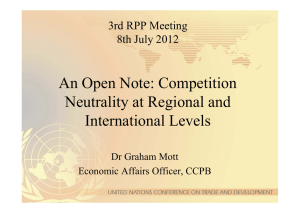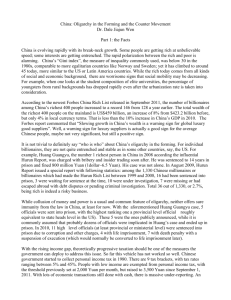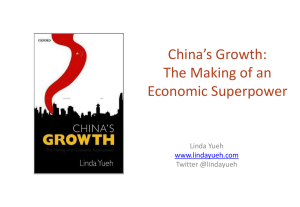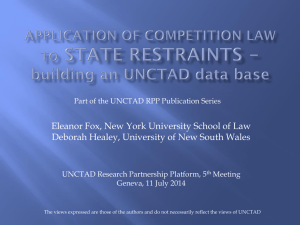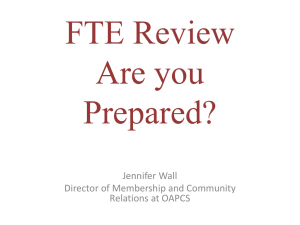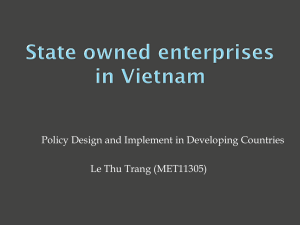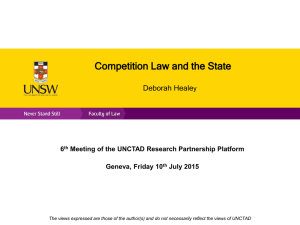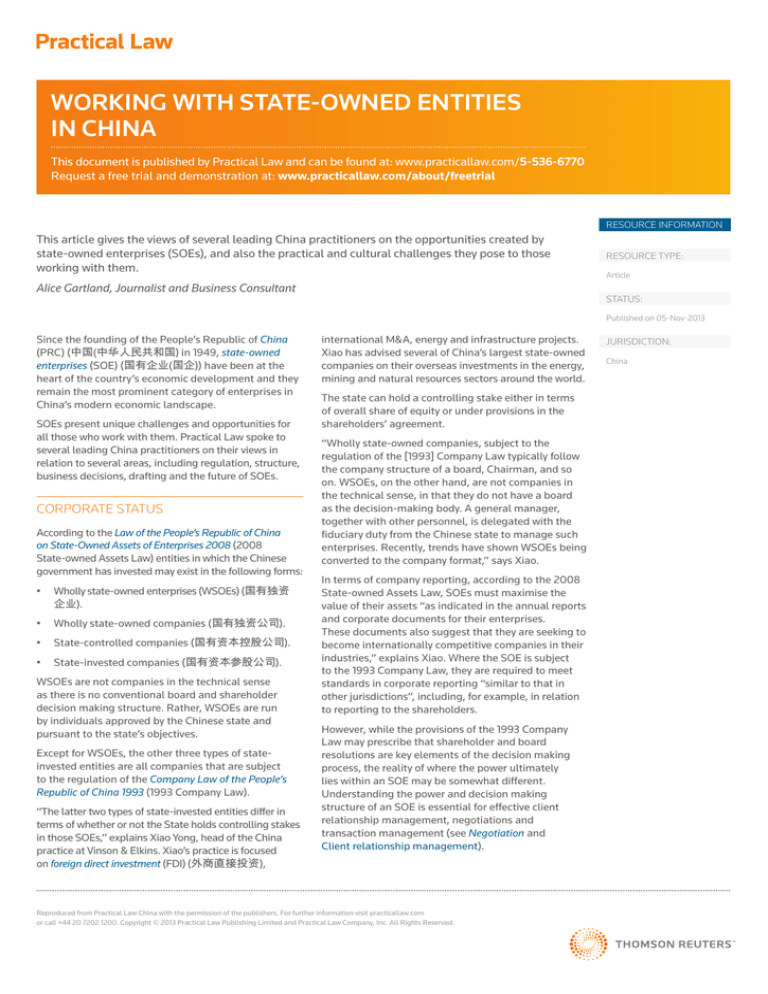
WORKING WITH STATE-OWNED ENTITIES
IN CHINA
This document is published by Practical Law and can be found at: www.practicallaw.com/5-536-6770
Request a free trial and demonstration at: www.practicallaw.com/about/freetrial
RESOURCE INFORMATION
This article gives the views of several leading China practitioners on the opportunities created by
state-owned enterprises (SOEs), and also the practical and cultural challenges they pose to those
working with them.
Alice Gartland, Journalist and Business Consultant
RESOURCE TYPE:
Article
STATUS:
Published on 05-Nov-2013
Since the founding of the People’s Republic of China
(PRC) (中国(中华人民共和国) in 1949, state-owned
enterprises (SOE) (国有企业(国企)) have been at the
heart of the country’s economic development and they
remain the most prominent category of enterprises in
China’s modern economic landscape.
SOEs present unique challenges and opportunities for
all those who work with them. Practical Law spoke to
several leading China practitioners on their views in
relation to several areas, including regulation, structure,
business decisions, drafting and the future of SOEs.
CORPORATE STATUS
According to the Law of the People’s Republic of China
on State-Owned Assets of Enterprises 2008 (2008
State-owned Assets Law) entities in which the Chinese
government has invested may exist in the following forms:
• Wholly state-owned enterprises (WSOEs) (国有独资
企业).
• Wholly state-owned companies (国有独资公司).
• State-controlled companies (国有资本控股公司).
• State-invested companies (国有资本参股公司).
WSOEs are not companies in the technical sense
as there is no conventional board and shareholder
decision making structure. Rather, WSOEs are run
by individuals approved by the Chinese state and
pursuant to the state’s objectives.
Except for WSOEs, the other three types of stateinvested entities are all companies that are subject
to the regulation of the Company Law of the People’s
Republic of China 1993 (1993 Company Law).
“The latter two types of state-invested entities differ in
terms of whether or not the State holds controlling stakes
in those SOEs,” explains Xiao Yong, head of the China
practice at Vinson & Elkins. Xiao’s practice is focused
on foreign direct investment (FDI) (外商直接投资),
international M&A, energy and infrastructure projects.
Xiao has advised several of China’s largest state-owned
companies on their overseas investments in the energy,
mining and natural resources sectors around the world.
The state can hold a controlling stake either in terms
of overall share of equity or under provisions in the
shareholders’ agreement.
“Wholly state-owned companies, subject to the
regulation of the [1993] Company Law typically follow
the company structure of a board, Chairman, and so
on. WSOEs, on the other hand, are not companies in
the technical sense, in that they do not have a board
as the decision-making body. A general manager,
together with other personnel, is delegated with the
fiduciary duty from the Chinese state to manage such
enterprises. Recently, trends have shown WSOEs being
converted to the company format,” says Xiao.
In terms of company reporting, according to the 2008
State-owned Assets Law, SOEs must maximise the
value of their assets “as indicated in the annual reports
and corporate documents for their enterprises.
These documents also suggest that they are seeking to
become internationally competitive companies in their
industries,” explains Xiao. Where the SOE is subject
to the 1993 Company Law, they are required to meet
standards in corporate reporting “similar to that in
other jurisdictions”, including, for example, in relation
to reporting to the shareholders.
However, while the provisions of the 1993 Company
Law may prescribe that shareholder and board
resolutions are key elements of the decision making
process, the reality of where the power ultimately
lies within an SOE may be somewhat different.
Understanding the power and decision making
structure of an SOE is essential for effective client
relationship management, negotiations and
transaction management (see Negotiation and
Client relationship management).
Reproduced from Practical Law China with the permission of the publishers. For further information visit practicallaw.com
or call +44 20 7202 1200. Copyright © 2013 Practical Law Publishing Limited and Practical Law Company, Inc. All Rights Reserved.
JURISDICTION:
China
WORKING WITH STATE-OWNED ENTITIES IN CHINA
GATEKEEPERS
In relation to publicly listed SOEs, Robert Woll, Partner
at Deacons in Hong Kong, who has over 20 years’
experience in PRC-focused and international M&A and
private equity, with substantial experience in relation
to SOEs, explains that, “typically, the listed entity is a
subsidiary carved out of the parent SOE.
The parent remains 100 percent state-owned.
The listed entity could be incorporated in China (listing
A shares or H shares) or in Hong Kong under the
Companies Ordinance. The latter are known in the
market as mainland-affiliated enterprises or ‘red chips’,
and this red-chip structure was in vogue from the late
1990s, with China Mobile as the best-known example,
through to around 2004. Recently, this red-chip
structure has given way to A share listings,
H share listings, or dual A-H share listings by
mainland-incorporated companies, governed by the
[1993] Company Law. The listed companies are also
governed by the securities laws of the jurisdiction
where they are listed (China, Hong Kong, the US,
and so on) and the rules of the relevant stock
exchange.” Several larger SOEs are also listed on US
and UK stock exchanges.
SOEs have evolved out of a range of institutions and
government ministries, so how the Chinese state is
represented in the structure of modern SOEs varies. In
relation to WSOEs and wholly state-owned companies,
Xiao explains that, in general, the State Council
(中华人民共和国国务院), through the State Asset
Supervision and Administration Commission (SASAC)
(国有资产监督管理委员会), “invests in the centrallevel SOEs”. According to SASAC’s website, there are
currently 116 central-level SOEs throughout many
industries, including armed forces, energy, power and
construction, among others (see www.sasac.gov.cn).
“Local governments, through SASAC’s branch division
at the local government levels, invest in local SOEs.”
Xiao adds, “SASAC’s power in the relevant SOEs is
analogous to the power of shareholders in a company”.
According to the 2008 State-owned Assets Law,
SASAC can:
• Appoint members to the supervision committee of
the SOEs.
For fund managers wishing to invest in natural
resources or telecoms in China, these publicly listed
companies offer virtually the only means to invest and
are an important channel for capital into China.
• Nominate candidates for management positions.
• Approve significant corporate matters, including
mergers, corporate restructuring, increase or
reduction of registered capital, issuance of bonds,
profit distribution, dissolution and petition
for bankruptcy.
“Except for those,” continues Xiao, “SASAC may not
intervene in the legitimate and independent business
operations of the SOEs.”
While SASAC’s influence may seem somewhat
restrictive, in reality their involvement varies. However,
again, it points to what can be a difference between the
rhetoric and the reality of where decision making power
lies in contemporary SOEs.
Additionally, although the financial contributor
to most SOEs is SASAC, many other government
ministries and commissions may also contribute
funds to SOEs. “For example the contributors for
SOEs in the banking, post and civil aviation industries
are government financial departments. Provisions
stipulated by SASAC on SOEs … do not directly apply
to these enterprises, where SASAC is not an investor
… legal application may vary according to the different
investors,” says Jihong Wang, Partner at Grandway Law
Offices in Beijing.
GROUP STRUCTURES
Large scale SOEs often have many subsidiaries,
however their investment funds will be planned and
allocated by their parent or controlling company.
For large investments, the subsidiaries “may have
to seek approval from the parent/controlling
company,” says Wang.
2 Practical Law • China
The state-owned parent company remains the majority
shareholder, although their listing prospectus will
make it clear that the majority shareholder (that stateowned parent) may not always act in the interests
of the minority shareholders. Beyond that, there are
not many prescribed rules governing the relationship
between the parent and subsidiary company. Clearly,
this raises the question of how that power relationship
will ultimately operate in practice. While many will
argue that it is exactly the same as any majority
shareholder situation, other observers may expect that
having a parent company owned by the Chinese state
gives rise to some significant risks.
Now that corruption is openly acknowledged as the
biggest issue facing China’s bureaucratic system, SOEs
operating in that wider context inevitably face significant
challenges in maintaining and developing standards
in transparency, accountability and compliance (this
issue is not only limited to listed companies). It remains
to be seen whether greater internationalisation of
China’s SOEs will be a catalyst for change or trigger the
unravelling of the business establishment.
“GO OUT” POLICY
SOEs have been at the forefront of the Chinese
government’s “go out” policy and are making investments
across the world in various sectors, from natural resources
and finance through to technology, R&D, innovation,
real estate and fashion. This increased visibility and
autonomy is raising questions around transparency and
accountability, both in a global context and within China.
Reproduced from Practical Law China with the permission of the publishers. For further information visit practicallaw.com
or call +44 20 7202 1200. Copyright © 2013 Practical Law Publishing Limited and Practical Law Company, Inc. All Rights Reserved.
WORKING WITH STATE-OWNED ENTITIES IN CHINA
SASAC has also set out some parameters for overseas
investments by SOEs. For example, Article 5 of the
Interim Measures for the Supervision and Management
of Overseas Investment of Central Enterprises 2012
(2012 Overseas Investment Interim Measures)
outlines certain principles that these investments
should follow, including:
• Meeting the needs of the national economy.
• Complying with the state industrial policy on
overseas investment. In principle, this requires
that a central-level SOE may not invest outside
of its main business without prior approval of
SASAC. The SASAC’s approval is required even
where an investment is within the SOE’s main
business. However, it is possible to submit an
annual investment plan to SASAC that compiles all
planned investments, which can be more efficient
than proceeding on a case-by-case basis.
In addition to SASAC approval for overseas
investments, SOEs may also be required to obtain
several regulatory approvals from different bodies
of the Chinese government. For those new to doing
deals with Chinese partners, this can be a little
unnerving although so far there have not been
any reports of major outbound investments being
blocked. The regulatory bodies that need to sign off on
overseas investments commonly include the National
Development and Reform Commission of China (NDRC)
(中华人民共和国国家发展和改革委员会国家法改
委)), the Ministry of Commerce (MOFCOM) (中华人民
共和国商务部) and the State Administration of Foreign
Exchange (SAFE) (国家外汇管理局).
As Xiao points out: “The bodies required to approve a
specific transaction depend upon the size and type of
the investment, and [these approvals] often require 60
days or more to obtain, potentially resulting in a slight
delay to a transaction”.
General timeline for the Chinese governmental approval process
Receive all
foreign
government
approvals
Submit
preliminary
report to
NDRC
Receive
preliminary
consent from
NDRC
Submit formal
approval
application to
NDRC
Key
NDRC:
National Development and Reform
Commission of China
SAFE:
State Administration of Foreign Exchange
MOFCOM: Ministry of Commerce
SPA:
Share purchase agreement
NDRC
approves the
transaction
Submit
approval
application to
SAFE
Approval
conditions
Submit
application
to MOFCOM
Pre-approvals and
communications
2-3 weeks
Receive
approval
from SAFE
Approval
obtained
MOFCOM
approves the
transaction
11-14 weeks
SPA signing
IMPORTS AND OPERATIONS
In addition to these gatekeepers, “compared to private
enterprises, Chinese foreign policy impacts more on
investment direction and scope of SOEs”, says Wang.
On the importation side, the regulation of SOEs is no
stricter than for private companies. However, Wang
explains that “SOEs can be greatly affected by state
regulation and control [in relation to] their operations
and investment in two keys ways: direct intervention
and indirect intervention.”
Wang further explains that “direct intervention, for
example, [occurs] where to maintain macro-control of the
real estate market, the government directly demands that
the key state-owned enterprises gradually withdraw from
the real-estate market and specifically lists which SOEs
are allowed to continue to invest in real estate projects.
Indirect intervention [can be seen], for example, where
the government adopts more lenient credit policies to
encourage investment in certain industries and fields,
and adopts restrictive credit policies to restrict investment
in certain other industries and fields. Those polices will
guide the investment of SOEs.”
Reproduced from Practical Law China with the permission of the publishers. For further information visit practicallaw.com
or call +44 20 7202 1200. Copyright © 2013 Practical Law Publishing Limited and Practical Law Company, Inc. All Rights Reserved.
Practical Law • China 3
WORKING WITH STATE-OWNED ENTITIES IN CHINA
DEALING WITH SOES: PRACTICAL AND
CULTURAL ISSUES
Similarly, Robert Woll at Deacons says that SOEs
do get called on by their government sponsors
“to undertake special projects”. However, it is not
always entirely clear how that is filtered down and
communicated through the organisation.
As the history, structure and regulation of SOEs
indicate, working with SOEs involves managing
several dynamics. It can feel like “SOEs have a unique
culture,” says He Fang, Partner at Jun He in Beijing
who specialises in M&A, inbound and outbound
investments and general corporate matters.
Identify and access the main decision makers
WHO AND WHAT IS DRIVING THE BUSINESS
DECISIONS?
For many, although SOEs may now generally be driven
by commercial considerations, they remain alter egos
of the state. It is a relationship that can influence all
stages of a transaction.
Many observers feel that the line between state
and private enterprise is increasingly blurred and
inevitably there are tensions and ambiguities that
external advisers and business partners must deal
with. This transformation process is also something
that the SOEs themselves need to come to terms with
from an organisational and business development
perspective, particularly as they seek to compete on the
international stage.
The perceptions of SOEs vary considerably.
To the suspicious, they are “’arms of the Chinese
government following a path of state sponsored
economic imperialism (as opposed to an independent
commercial agenda)’, but by others they are viewed
as commercially driven organisations, amply able and
willing to compete against one another in the pursuit
of profit, and whose management is increasingly made
up of a new generation of internationally minded
Chinese business people.
The legacy of the past (see box, SOEs in China: history)
still permeates the behaviour of SOEs and while on a
day-to-day level the state may exhibit little control, it
remains the ultimate choreographer one way or another.
NEGOTIATIONS
Policy factors
“[The SOE’s] Officers may not always be responding
directly to commercial factors,” says Amy Sommers,
Partner, K&L Gates in Shanghai who is a specialist in
PRC focused M&A. They “may be being called upon
to achieve certain policy aims and there may be a
“soft policy directive”. As such, “some of the things
that [normally] give you leverage in a commercial
transaction may not get you leverage in this context.
There are things that may be on their radar screen that
simply aren’t on yours”.
The timing of a transaction could be driven by when two
local managers will be able to meet with the other party,
and policy factors may also have an impact on or even
drive negotiations. For example, SOEs in the aviation
manufacturing sector are currently under intense
pressure to meet government deadlines on production.
4 Practical Law • China
When negotiating in China, it is important to know
who you are speaking to. It sounds basic, but it may
be that the person you are in direct communication
with is not actually the main decision maker. “In fact,
SOE personnel assigned to speak to outside lawyers
often are not in a position to make decisions or even to
communicate outside legal advice effectively to those
more senior in the SOE hierarchy, which is very strictly
observed. This can be a significant risk factor for legal
practitioners, particularly foreign lawyers, who cannot
be certain that their advice is being heard or conveyed to
the actual decision makers. It is unusual for members of
the SOE’s party committee, where the real power lies, to
meet with outside ‘technical’ advisors’,” says Woll.
Accessing the real decision makers or ensuring
that your messages are clearly and effectively
communicated to them can take time and a lot of skill.
To find out who the main decision makers are, you need
to do your research. It is not always easy.
If you have a small team of lawyers, the other
professional advisers involved in your deal may be better
placed to investigate who within the SOE will make the
final decision. In particular, the banks often have larger
teams working on a transaction than the China office
of an international law firm. In addition, there may be a
more obvious ‘way in’ to the SOE for them because they
will have a relationship with the CFO.
SASAC has been pushing for SOEs to develop stronger
in-house legal teams and many of the larger SOEs are
doing that to the point where they are less reliant on
external counsel. However, in general, they still have a
long way to go. The legal function is also still separate
from the business decision making process. While that
is a dynamic common to several jurisdictions, it is more
exaggerated in the context of SOEs who are in the early
stages of developing their in-house legal capability.
Project managers on a transaction may also be
more junior members of SOEs. Often internationally
educated and fluent in English and other languages,
they may also be faced with the tricky task of acting as
a bridge back to their senior management, who may
not have such an international mindset, or “may never
have been out of the country,” says Dina Yin, Partner
at King & Wood Mallesons in Beijing who specialises in
helping large SOEs with their outbound investments.
Keep in mind that the junior people negotiating on
behalf of the SOE may be subject to criticism from their
bosses unless they are seen to be reducing the external
party’s demand. “The Chinese party works on the
assumption that ‘if you tell me you want X, what you
really want is 20 or 30 per cent less than X’. So, if the
junior is not succeeding in paring back [your demands]
they may not gain credibility with their superiors and
Reproduced from Practical Law China with the permission of the publishers. For further information visit practicallaw.com
or call +44 20 7202 1200. Copyright © 2013 Practical Law Publishing Limited and Practical Law Company, Inc. All Rights Reserved.
WORKING WITH STATE-OWNED ENTITIES IN CHINA
may then struggle to get buy in from their superiors
later on when they seek approval for the negotiated
terms,” explains Sommers.
Further, large SOEs tend to have many departments,
each of which has functions that are clearly delegated and
defined, and each department will have strict reporting
procedures. Additionally, when working with SOEs you
may have individual contact points for each department,
which can require time and diplomacy to co-ordinate.
Regional differences in commercial awareness
and sophistication
Some practitioners observed that there were
differences in commercial awareness and
sophistication between central and local level SOEs.
One felt that SOEs from South China tended to be
more commercially minded than their counterparts
elsewhere. Although anecdotal, this may illustrate the
influence of China’s early strategy to opening up the
economy that had its roots in the southern provinces
close to Hong Kong.
Yin also points out that while SOEs “will ask for things
like a MAC [material adverse change] clause, a lot of
the time the character of the deal is driven by where
the deal is being done and what the industry standard
is there. So in China they are less likely to ask for those
things because they are familiar with the system; but
say in the UK or the US, they are more keen to know the
usual business standards for contract provisions and
prefer to adhere to them without much deviation.”
“In the US and UK it’s all about ‘buyer beware’ and it’s a
litigation driven environment. Sometimes it takes time
for SOEs to familiarise themselves with that and while
they increasingly use a ‘common language’ in drafting
provisions, it is still a learning process,” explains Yin.
Certainly, once an SOE has become involved in litigation
it “changes attitudes pretty quickly”.
It is also about experience and the passage of time
as “the ones that have more exposure with outbound
investment are more comfortable and are on the same
page as their Western counterparts. For the rest, it will
be a quick learning process, I’d imagine,” says Yin.
Practical points
All these factors can make the decision making process
slower. “It’s manageable but project partners need
to be aware of that,” says Ulrike Glueck, Managing
Partner at CMS in Shanghai. Glueck has been working
in China for more than 15 years and specialises in
M&A and corporate projects. She advises foreign
multinationals on investment and restructuring in
China and Chinese companies on investments abroad,
in particular in Europe.
It may also mean that there are frequent changes to
the structure of a project and a “higher frustration
threshold may be required [to deal with those frequent
changes]. If you have lots of time to do the amended
work it’s fine, but if there’s a tight deadline then it’s
more challenging,” says Glueck.
All the lawyers we spoke to emphasised how increasingly
international many SOE employees are in their outlook
and that they are often fluent in other languages.
Nevertheless, as Xiao explains “as a practical matter,
although an increasing number of SOE employees speak
English, it is greatly helpful to communicate with them
in Chinese. Ideally, outside counsel would not only speak
Chinese but would also have cultural fluency in order to
avoid miscommunication regarding the Chinese party’s
intention during negotiations and other stages of
the transaction.”
DRAFTING
Differences in the approach to drafting documents may
confuse those from outside China. Yin explains that the
SOE counterpart may not share “what we [in Europe
or the US] take for granted in terms of execution dates
and how complete a document needs to be”. It is more
about “the overall deal, the commercial terms, and
how one perceives the long term relationship is with
their business counterpart”.
VISAS AND NATIONAL HOLIDAYS
Beyond the gatekeepers, cultural differences and
organisational politics, it is also important to
factor in visas and national holidays to your China
transaction timeline.
Chinese citizens require visas to visit and do business in
many jurisdictions where citizens from other countries
may not have the same requirement. Therefore,
Chinese parties often require extended notice for
meetings. “If meetings cannot be conducted via
conference calls or have to happen at short notice it
may be that the counterparties of SOEs ‘need to travel
to mainland China or Hong Kong’ to minimise the
impact of visa delays on the transaction timeline,” says
Xiao. Also, remember the importance of particular
holidays in China when “SOE employees may be
difficult to reach … among these holidays the Chinese
New Year Holiday ranks highest in importance”.
CLIENT RELATIONSHIP MANAGEMENT
As already explained, there are various issues
connected to SOEs that may impact on the timing
and flow of a transaction that can be confusing and
frustrating for the counter-party at times. Sommers
recommends that if you have a team that is not
familiar with doing transactions in China, then bringing
“external counsel in at an early stage of any planned
transaction with SOEs is advisable”.
On the SOE side, building an effective relationship
either as a business partner or professional adviser
with SOEs takes a long time. Sometimes, SOEs may
be constrained by internal issues and it is their legal
counsel that must help guide them through that.
Reproduced from Practical Law China with the permission of the publishers. For further information visit practicallaw.com
or call +44 20 7202 1200. Copyright © 2013 Practical Law Publishing Limited and Practical Law Company, Inc. All Rights Reserved.
Practical Law • China 5
WORKING WITH STATE-OWNED ENTITIES IN CHINA
From the outset there can be differences. One lawyer
described how engagement letters may often contain
more elaborate obligations than usual and emphasised
the need to be clear about what you can deliver,
particularly if you are a small team. They also pointed
out that SOEs are used to getting discounts in all areas
of their business operations and the same was often
expected for the provision of legal services. While
payment of fees was never a problem, several lawyers
commented that where there was a fixed fee for a
transaction, that could become challenging if there
were a lot of changes to the deal structure and delays.
“Building trust is not that simple,” says Cathy Yeung,
Partner and Co-Chair of the Greater China practice at
Latham & Watkins and based in Hong Kong. Yeung has
been working with SOEs for 20 years and explains that
“it’s a challenging job. It takes a long time and requires
a lot of effort”.
SOEs operate at the nexus of China’s economic,
political, and business cultures and their fate is a
powerful symbol of the country’s fortunes.
There are significant issues for them to overcome but
their success is an essential part of ensuring China’s
consistent and effective economic development.
That is not just a concern for the Chinese government.
The expansion of SOEs overseas also means that their
fate is entwined with that of the global economy.
One structure no longer fits all (for detail on the
years when one structure did fit all, see box, SOEs in
China: history). It is in everyone’s interest to increase
mutual understanding and improve SOE business
performance, and this is likely to keep many lawyers
busy for a while to come.
Yeung has worked with several large SOEs as they
have expanded overseas and along the way helped
them with a variety of in-house training on issues like
the corporate governance regulatory requirements
of different stock exchanges. Yeung says that “it’s
mutually beneficial” and helps build the trust and
understanding required to work together effectively on
deals. But it is not just about legal and communication
skills. It is “interpersonal skills” that are paramount.
As a Chinese national, Yeung also feels that she is in a
strong position to better understand the business and
economic rationale behind the decisions of her clients.
Over the last ten years in particular, Yeung has seen
the larger SOEs become increasingly sophisticated
and internationally minded, “especially in relation to
outbound investment, where overseas listings have
brought them even closer to international markets”.
Yin also describes the “big time commitment” involved
and notes that SOEs are becoming more discerning
about which law firms they engage. “It’s more than
just an institutional relationship. It doesn’t work in the
same way as what we are used to [in the US]. It still
matters very much on a personal level that they have
worked well with you,” says Yin. Eventually, as the
in-house teams are growing and expanding, SOEs will
also become less reliant on external counsel.
In terms of recruitment in general, SOEs are looking to
international markets to attract the best people with
the right skill set to pursue their global ambitions.
LOOKING AHEAD
It is clear that the role of legal counsel (whether
working directly or indirectly with SOEs) is a
challenging one, but also integral to SOEs’ ability to
adapt and evolve into sophisticated, well managed and
modern organisations. If both sides get it right, it is
potentially hugely rewarding.
6 Practical Law • China
Reproduced from Practical Law China with the permission of the publishers. For further information visit practicallaw.com
or call +44 20 7202 1200. Copyright © 2013 Practical Law Publishing Limited and Practical Law Company, Inc. All Rights Reserved.
WORKING WITH STATE-OWNED ENTITIES IN CHINA
SOES IN CHINA: HISTORY
In relation to all sectors of the economy until the 1980s and 1990s, the SOE concept could be placed (fairly
neatly) into one category: WSOEs. It was a case of one structure fits all.
Historically, WSOEs have not been commercially driven and have been characterised as cumbersome,
inefficient and, in general, found to be incompatible with the aspirations of the modern Chinese state.
During the 1980s and 1990s, a process of corporatisation took place in China with the aim of transforming
many of these WSOEs into modern commercial entities. This was due to a combination of factors, including:
• The opening up of the economy.
• The desire to attract foreign capital (for example, through joint ventures).
• The growing burden of underperforming loans to SOEs.
The Decision on Issues Concerning the Establishment of a Socialist Market Economic Structure was passed in
1993, following which a series of laws and regulations related to SOE reform were promulgated. China’s 1993
Company Law was also promulgated during this time and has been revised several times since, which has had
a significant impact on the reform of SOEs. “The modern enterprise system has become the focal point of SOE
reform in China since then,” explains Jihong Wang, partner at Grandway Law Offices in Beijing, who specialises
in corporate, construction, infrastructure and energy law. “Today, newly-set-up SOEs may be established either
as limited liability companies or joint stock limited companies. Limited partnerships are also now permitted”
and there has been a general trend towards converting WSOEs into corporate structures.
This legislative change made a big impact. “Prior to the [1993] Company Law, there was no real need for
corporate governance structures and processes,” says Amigo Xie, partner and specialist in PRC-focused M&A
at K&L Gates in Shanghai. Following the legislative change, there has been, and continues to be, a significant
change in management culture and systems.
A recent phase of this transformation process has involved creating greater liquidity in many enterprises
through the trading of shares on the mainland, Hong Kong and international stock exchanges. Several SOEs
are now also publicly listed companies.
Reproduced from Practical Law China with the permission of the publishers. For further information visit practicallaw.com
or call +44 20 7202 1200. Copyright © 2013 Practical Law Publishing Limited and Practical Law Company, Inc. All Rights Reserved.
Practical Law • China 7

